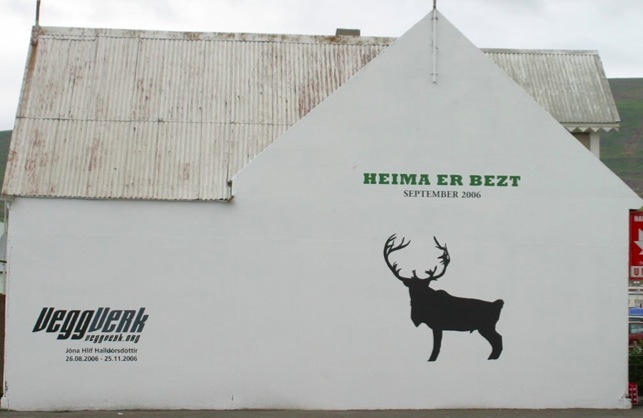
HEIMA ER BEZT
Verkið Heima er bezt er blanda af málverki og pólitísku innleggi í anda hefðbundins veggjakrots. Sem málverk takmarkast verkið af eðli Gallerísins VeggVerk. Þannig á þetta verk, og þau sem á eftir munu koma, styttri líftíma en hefðbundin málverk, því listamennirnir munu allir nota sama rýmið. Einnig tók sú málning, sem notast var við við gerð verksins, mið af því að verkið er útiverk, og segja má að mótífið geri það líka. Mótífið mátti ekki vera of lítið því ljóst var að verksins yrði fyrst og fremst notið úr fjarlægð.
Efni verksins er sótt úr tvennum áttum sem tengjast. Þau eru annars vegar Kárahnjúkavirkjun og hins vegar tímaritið Heima er Bezt. Einnig má segja að verkið skiptist í þrjá hluta. Í fyrsta lagi er aðalmótíf verksins hreindýr í fullri stærð (sem reyndar hefur komið nokkrum sem sjá það á óvart, því þeir telja hreindýr yfirleitt vera stærri). Hreindýrið, eða hjörturinn, er goðfræðilegt tákn (t.a.m. er hjörturinn kristilegt trúartákn, auk þess sem hirtir bitu barr á Aski Yggdrasils í norrænni goðafræði), en fær pólitíska skírskotun í ljósi tímasetningarinnar sem máluð er á vegginn: September 2006. Þessi tímasetning er annar hluti verksins en í næsta mánuði er áætlað að hleypa vatni á stífluna við Kárahnjúka. Við það hverfur stór hluti heimaslóða íslensku hreindýranna undir vatn.
Þriðji hluti verksins er setningin Heima er bezt, sem er jafnframt heiti verksins. Setninguna mætti skilja sem kaldhæðna staðhæfingu í ljósi örlaga heimkynna hreindýranna. Henni er þó einnig ætlað að kveikja hjá fólki tengsl við tiltekið tímarit sem var vinsælt á heimilum landsmanna á 20. öldinni. Það var sérstaklega vinsælt á sveitaheimilum og birti iðulega viðtöl við bændur eða búalið. Leturgerðin sem notuð er við textann í verkinu er sótt til þessa tímarits. Þannig er við nánari skoðun annað lag í verkinu út frá tímaritinu og tengslum þess við bændur landsins (helstu stuðningsmenn Framsóknarflokksins, en fv. iðnaðarráðherra þess flokks ber samkvæmt lögum ábyrgð á Kárahnjúkavirkjun.)
texti:Hjálmar Stefán Brynjólfsson
Heima er Bezt is a political graffiti installation. Unlike the traditional images one has of modern graffiti with it’s use of bright colours and cartoon visuals, this piece reminds one of the forms origins in paintings and writings of the ancient Greeks.
The canvass is Gallerí VeggVerk “Gallery Graffiti”, which is a wall of a house in Akureyri, Iceland. In contrast to conventional paintings on conventional canvasses, this painting and other installations that will follow will have a reduced shelf life, as the all the artists will be using the same wall for their canvas.
The ideation behind the installation is derived from two different, though connected ideas: The building of a Hydroelectric Dam in the East of Iceland called Karahnjukavirkjun which has been controversial because of the detrimental effect environmentalists believe it will have on the environment, and a Icelandic landscaping and a lifestyle magazine called Heima er Bezt.
The installation can be divided into 3 main parts. The first part, which is the main motive, is a painting of a life size reindeer stag. Traditionally, the deer has significant roles in various mythologies (for instance Greek and Norse mythology) but in this context it has a political meaning due to the date painted on the wall, September 2006. The date is the second part of the installation for in September 2006, the building of the Hydroelectric Dam will reach the stage when it will start to collect water and flood a large part of the Icelandic Reindeer’s habitat.
The third part of the installation is the sentence Heima er Bezt (which translates “home is the best place to be”) which is also the installation’s title. Not only does the sentence ironically refer to the reindeer’s habitat being flooded; it also refers to the lifestyle magazine Heima er Bezt, which was widely read in Iceland in the early 20th century. The magazine was especially popular with people from the countryside, as it focused on farming and the country life. The font used in the sentence is also the same as that used in the magazine.
The sentence also reveals another political (and perhaps ironic) level to the installation due to the connection between the magazine, and it’s core readership (farmers) who are traditional followers of the Progressive Party, an Icelandic political party. One of the party’s members was a former Industrial Minister who passed the legislative bill giving the go ahead for the dam and thereby partly responsible for the ruin of the reindeer habitats, Icelandic landscape and other environmental effects of the dam.
text: Sigríður Harpa Halldórasóttir